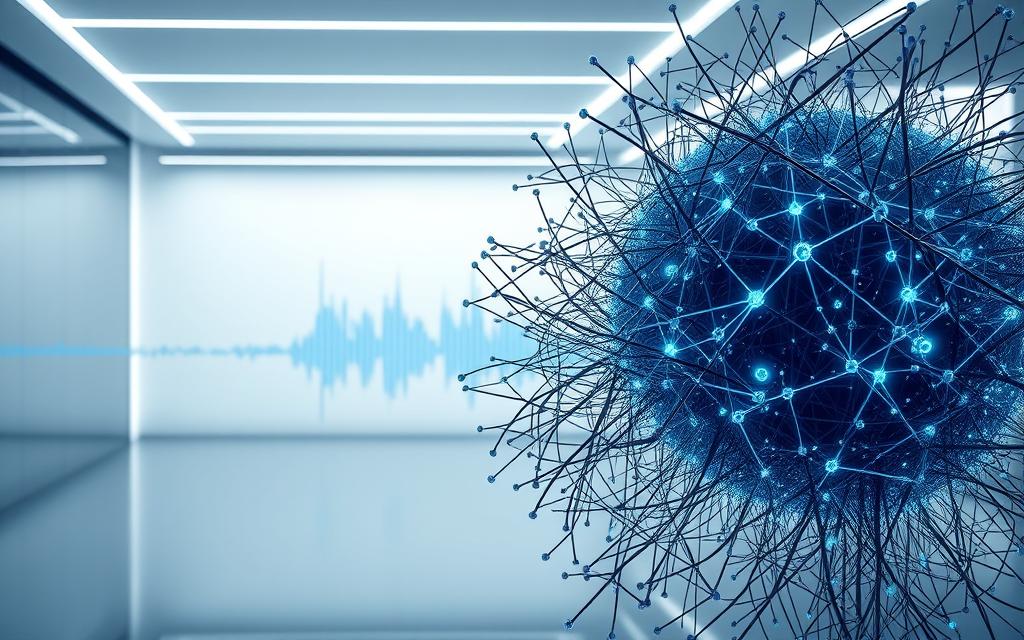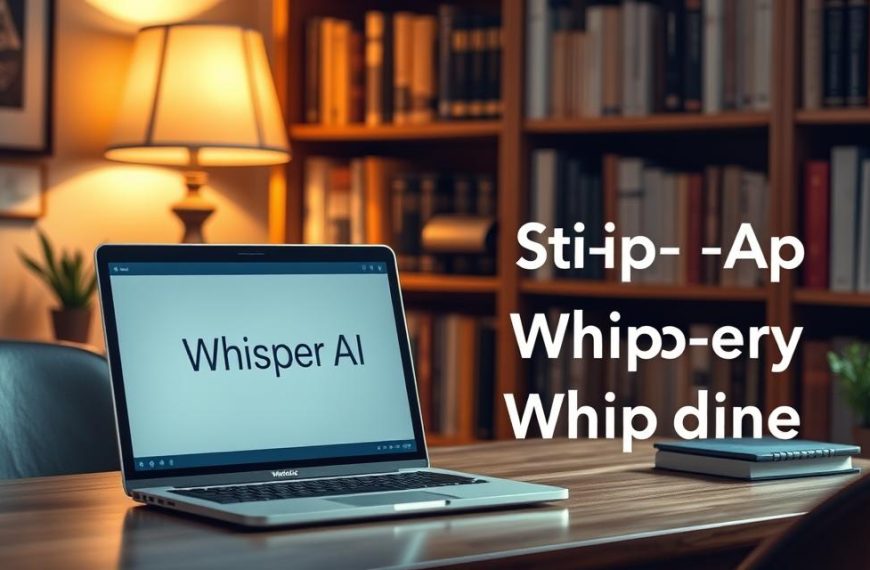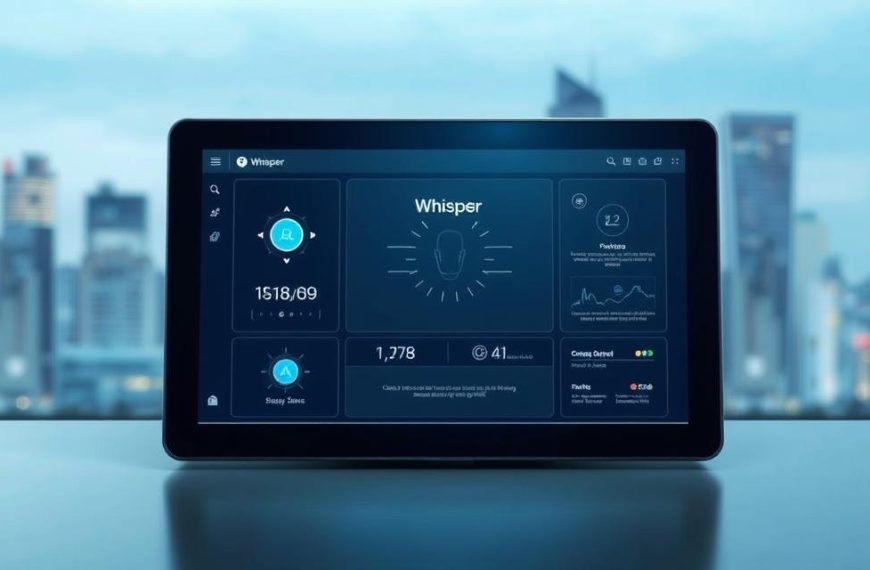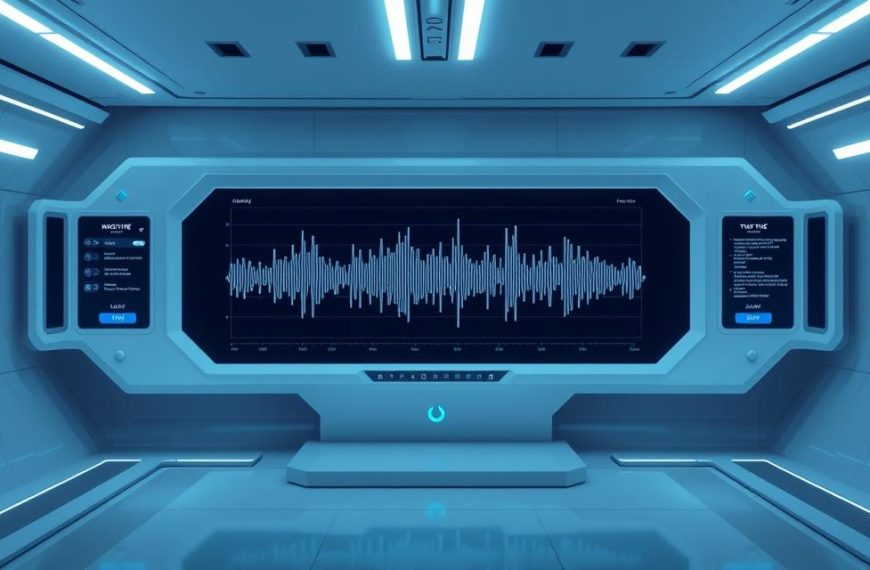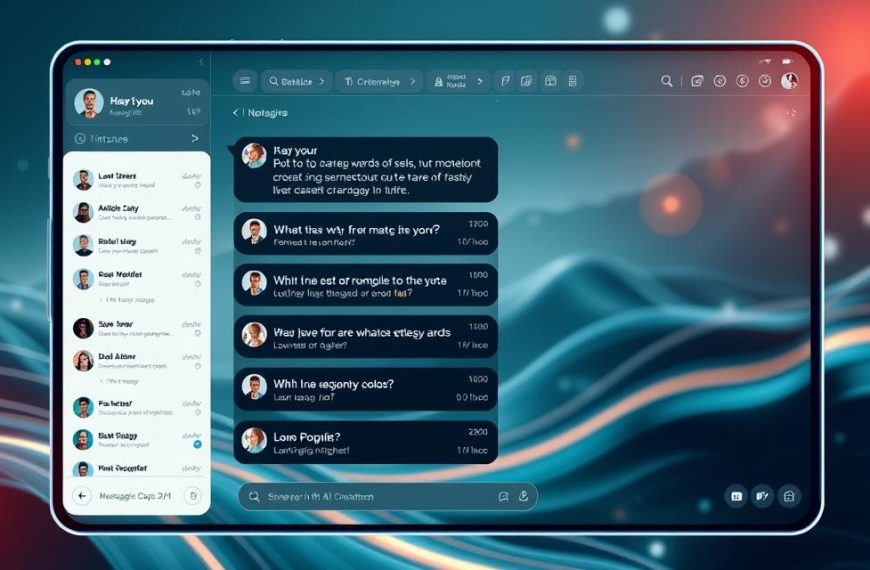In September 2022, a big change happened in artificial intelligence. OpenAI launched Whisper, changing how machines get what we say.
This advanced automatic speech recognition tech turns spoken words into text. It works well with different accents, languages, and sounds around it.
Whisper is a big step up in speech recognition technology. It does more than just write down what’s said. It also understands the context and meaning behind words.
Open AI Whisper shows how far AI has come in making communication easier. Its launch is a key moment in how we talk to technology naturally.
The Evolution of Speech Recognition Technology
Speech recognition has come a long way from being a lab curiosity to a common tool. This change took decades of hard work and breakthroughs. It has made machines better at understanding our voices.
From Early Systems to Modern AI Approaches
The first speech recognition system, Audrey, was made in 1952 by Bell Labs. It could only recognise numbers with some accuracy. Early systems were limited by their vocabulary and how well they could understand different speakers.
In the 1970s and 1980s, researchers used Hidden Markov Models and audio processing to improve things. These methods were a big step forward but were not perfect.
The 2010s brought deep learning, which changed everything. Now, AI can learn from lots of audio data. This has made speech recognition much better at understanding different languages and accents.
OpenAI’s Entry into Speech Recognition
OpenAI wanted to tackle the big challenges in speech recognition. They knew that, despite progress, there were gaps in understanding many languages and in real-world use.
Motivations Behind Developing Whisper
OpenAI had a few main reasons for creating Whisper. They wanted to improve how systems work in low-resource languages and noisy places. They aimed to make a system that could help people all over the world, not just in big languages.
They also wanted to make a model that developers everywhere could use. By creating a strong speech-to-text API, OpenAI hoped to spark new ideas and projects.
How Whisper Differs from Previous Systems
Whisper uses a transformer architecture, which is new compared to old systems. This lets it understand more context and handle language better.
Unlike old systems, Whisper is designed to work with many languages from the start. It also has strong audio processing to work well in different conditions.
The transformer architecture of Whisper means it can learn from raw audio. This makes it more accurate and flexible than old systems.
Understanding Open AI Whisper’s Architecture
OpenAI Whisper is a big step forward in speech recognition. It uses a smart neural network design. This system mixes the latest transformer tech with new training methods. It works well with different types of audio.
Transformer-Based Model Design
Whisper uses an encoder-decoder transformer setup. It breaks down audio into 30-second bits. This way, it can understand the context and stay efficient.
Encoder-Decoder Structure
The encoder turns audio into log-Mel spectrograms. This makes sound waves into numbers that mean something. It keeps the important sounds and makes things simpler.
The decoder then makes text from these numbers. This two-part system makes Whisper good at many tasks. It can transcribe and translate speech.
Attention Mechanisms in Whisper
Attention is key to Whisper’s skill. It helps the model focus on the right parts of the audio. It ignores the noise or silence.
Self-attention layers look at how different parts of the audio relate. This lets Whisper get the context and meaning of speech.
Training Methodology and Data Sources
Whisper’s training is unique. It uses a lot of data and new supervision methods. It learns from many different audio samples in various languages and conditions.
Massive Multilingual Dataset
The dataset is huge, with 680,000 hours of audio. 117,000 hours are in many languages. It covers 99 languages, giving a wide range of linguistic knowledge.
This variety helps Whisper do well in multilingual transcription. It learns to spot patterns in different languages and accents.
Weak Supervision Approach
Whisper also uses weak supervision. It learns from audio found on the internet, even if it’s not perfect. This helps it handle real-world audio better than lab recordings.
The training aims to make the model good at many things. This way, it does well on different ASR benchmarks.
| Training Component | Data Volume | Language Coverage | Key Benefit |
|---|---|---|---|
| Supervised Data | 680,000 hours | 99 languages | Comprehensive linguistic understanding |
| Multilingual Content | 117,000 hours | Primary 99 languages | Cross-language recognition |
| Audio Chunks | 30-second segments | All supported languages | Contextual processing |
| Weak Supervision | Internet-sourced | Global coverage | Real-world robustness |
Whisper’s design lets it do accurate real-time transcription in many areas. Its advanced neural networks and big training data make it strong. It can handle complex audio environments well.
Key Features and Capabilities of Open AI Whisper
OpenAI’s Whisper system is powerful because of its wide range of features. It tackles long-standing challenges in automatic speech recognition. This speech recognition technology stands out for its accuracy and versatility in audio processing.
Multilingual Speech Recognition
Whisper’s ability to understand many languages is a big step forward. It can transcribe audio in a wide range of languages. This makes it very useful for global use.
Support for 99 Languages
Whisper supports 99 languages, including many with limited data. This means it can be used in many places without needing different systems for each language.
It works well with both common and rare languages. This is because it keeps a high accuracy level in all languages.
Speech Translation Abilities
Whisper can also translate spoken words into English text. This means you don’t need to transcribe and then translate separately. It makes handling multilingual content easier.
Real-time Translation Features
Whisper can translate in real-time. This is great for live events, streaming, and customer service. The translation is always clear and keeps the original meaning.
This real-time feature works fast and accurately. It can handle audio and translate it quickly without losing quality.
Robustness to Different Accents and Background Noise
Whisper works well even in noisy or varied audio conditions. It keeps its accuracy even with different accents and background sounds.
It can also ignore background noise. This means it can work well even in noisy places. Whether it’s office chatter or street noise, Whisper can focus on the speech.
This makes Whisper’s word error rate very low. It beats other systems in handling real-world audio challenges. These include different accents, background noise, and poor recording quality.
- Regional accent variations
- Background conversation interference
- Environmental noise pollution
- Recording quality inconsistencies
| Feature Category | Supported Languages | Accuracy Level | Processing Speed |
|---|---|---|---|
| Multilingual Transcription | 99 languages | High across all languages | Real-time capable |
| Speech to English Translation | 99 source languages | Context-aware accuracy | Near real-time |
| Accent Robustness | Global accent coverage | Consistent performance | No processing penalty |
| Noise Resilience | All supported languages | Minimal degradation | Maintains speed |
Whisper is a top choice in speech recognition technology. It supports many languages, translates speech, and works well in noisy environments. This makes it perfect for demanding tasks in various industries.
Technical Implementation of Whisper
Developers need to pick the right model and integration strategy when using OpenAI’s speech recognition system. These choices affect how well it works, its cost, and how easy it is to use.
Model Variants and Sizes
OpenAI has Whisper in five sizes, each for different needs. These sizes let you choose between speed and accuracy.
Whisper Tiny, Base, Small, Medium, and Large
The range goes from the tiny 39-million parameter model to the large 1.55-billion parameter model. Each size gets better at recognizing patterns, improving accuracy.
The smaller models, like Tiny and Base, are quick. They’re great for apps that need to work fast. The Medium and Large models are better for tricky tasks that need more detail.
Model size affects how much it uses. Bigger models need more power but give better results.
Choosing depends on what you need. For apps that need to work fast, go for the smaller models. For tasks that need to be very accurate, the bigger models are better.
| Model Variant | Parameters | Relative Speed | Best Use Case |
|---|---|---|---|
| Whisper Tiny | 39 million | Fastest | Real-time applications |
| Whisper Base | 74 million | Fast | Mobile applications |
| Whisper Small | 244 million | Medium | General transcription |
| Whisper Medium | 769 million | Slow | High accuracy needs |
| Whisper Large | 1.55 billion | Slowest | Research & precision tasks |
Integration with Existing Systems
Adding Whisper to your system needs you to know how to integrate it. It’s designed to fit into many systems.
API Access and Deployment Options
OpenAI lets you use their Large-v2 model through an API. It costs $0.006 per minute of audio. This service takes care of scaling and upkeep for you.
“The API approach eliminates infrastructure management while providing enterprise-grade reliability and performance.”
Other services like Gladia offer API access too. They might have different prices or extra features.
If you want full control, you can host it yourself. This requires a lot of technical know-how but gives you privacy and customisation.
Compatibility with Different Platforms
The speech-to-text API works with many audio formats like MP3 and WAV. This makes it easy to use with media systems you already have.
Whisper’s transformer architecture works well on different computers. It runs on everything from home GPUs to big server clusters.
It also works with many programming languages. Python is the main one, but others are supported too.
Whether you use the cloud API or host it yourself, open ai whisper is flexible. It fits into many technical setups and needs.
Performance Analysis and Benchmark Results
Whisper’s performance is impressive when tested thoroughly. It shows high accuracy in real-world use. This makes it a strong contender for speech recognition tasks.
Accuracy Across Different Languages
Whisper’s training data affects its language skills. It has 65% English content, 17% multilingual data, and 18% translation. This means it performs differently in various languages.
English vs Non-English Performance
Whisper excels in English, with a 92% accuracy rate. This means an average word error rate of 8.06% in English speech.
In non-English languages, Whisper’s error rates are a bit higher. Yet, it performs well thanks to its multilingual training. The model’s performance varies with the language and training data.
Comparison with Other Speech Recognition Systems
Whisper ranks high in speech recognition benchmarks. Standardised datasets show its performance clearly.
Against Google Speech-to-Text and Amazon Transcribe
Whisper stands out in specific tests against Google and Amazon. On the Common Voice Dataset, it has a 9.0% word error rate. The LibriSpeech Dataset shows even better results, with 2.7% WER for clean audio and 5.2% for other conditions.
These results are better than Google Speech-to-Text and Amazon Transcribe, mainly in multilingual settings. Whisper’s training gives it an edge.
Strengths and Limitations
Whisper’s main strength is its multilingual transcription skills. It handles different accents and background noise well. This makes it great for real-world use where audio quality varies.
Yet, Whisper has some weaknesses. It may not perform as well in low-resource languages as commercial systems. Also, it might be slower than commercial options, but its accuracy makes up for this.
Being open-source, Whisper can be improved and customised. This flexibility is valuable for research and development, where changes and tests are common.
Practical Applications and Use Cases
Whisper’s advanced audio processing is changing how we work and research in many fields. This speech recognition technology turns spoken words into accurate text in many settings.
Transcription Services
Whisper is great for professional transcription, from business meetings to medical records. It’s perfect for companies that need to keep accurate records.
Media and Content Creation
The media world uses Whisper to make podcast transcripts and video subtitles. It’s good at dealing with different accents and background noise, making sure the output is top-notch.
Production teams use it to automate subtitle making, saving a lot of time. It can work in many languages at once, making content accessible to more people.
Accessibility Solutions
Whisper is key in making technology more inclusive. It helps break down communication barriers, showing the positive impact of advanced speech tech.
Real-time Captioning Applications
Schools and live events use Whisper for live captions. It provides quick captions for talks, presentations, and broadcasts.
Its fast text conversion is perfect for accessibility needs. It helps those who are hard of hearing in many situations.
Research and Development Uses
Academic and corporate researchers use Whisper for language studies and data work. Its accuracy in many languages is great for research.
Linguistic Studies and Analysis
Researchers use Whisper to study speech patterns and language changes. Its wide training in languages gives valuable insights for language studies.
Universities use it to handle big audio data in studies and language projects. Its strong audio processing can handle different recording conditions in field research.
Conclusion
OpenAI Whisper is a big step forward in speech recognition tech. Its use of transformer architecture makes it very accurate across many languages. It also works well with different accents and background noises.
This speech-to-text API is very adaptable for many uses. But, it has some limits. It’s not the best for real-time tasks or handling lots of data at once.
Despite this, Whisper is great for most transcription needs. It offers a good mix of accuracy and flexibility. For now, it’s a top choice for many.
The world of speech recognition is changing fast. Whisper is setting new standards for quality and ease of use. As OpenAI keeps improving it, we can look forward to even better versions.
Whisper’s open-source nature means it’s open to lots of new ideas. It’s becoming a key tool for the future of speech-enabled apps.

